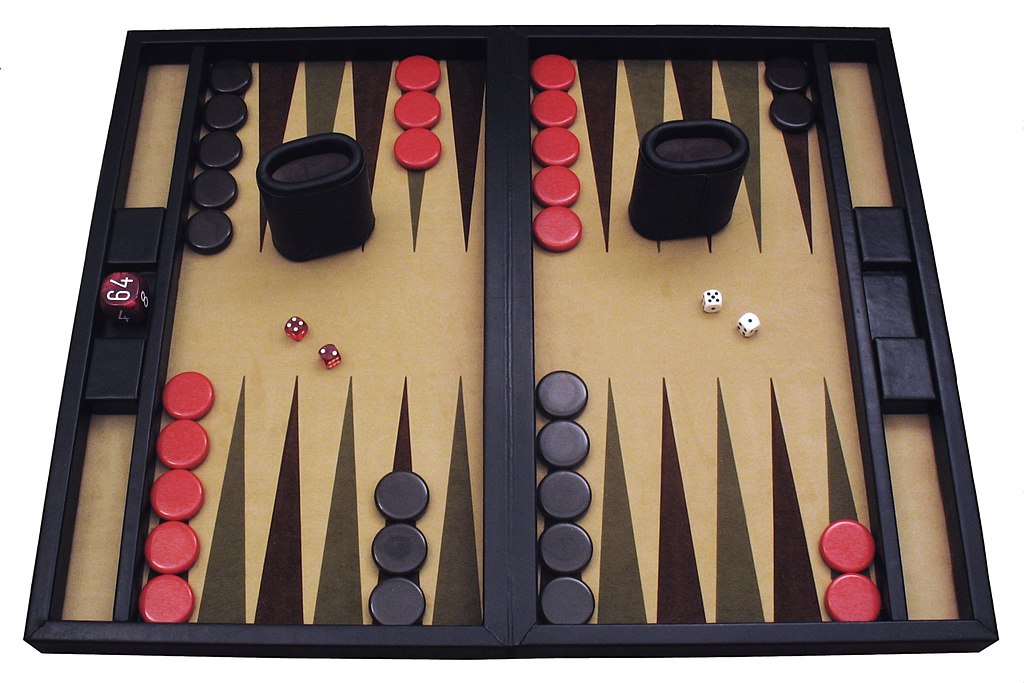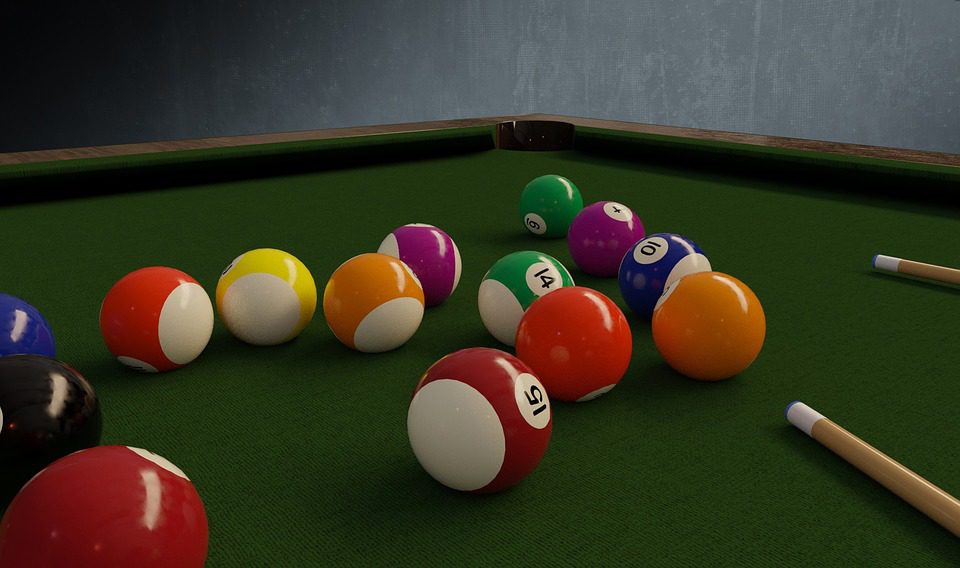There might be some of you who might be professionals at playing the game of backgammon. On the flip side, there  might be some who are novices, including myself. I have experiences with playing chess and checkers. Backgammon, on the other hand, not so much. I could recall buying a checkers board game with a checkers board on one side and a backgammon board on the other side. Now, I feel that backgammon is not as popular as checkers, but that’s just my opinion. Some people may disagree, and that’s fine with me.
might be some who are novices, including myself. I have experiences with playing chess and checkers. Backgammon, on the other hand, not so much. I could recall buying a checkers board game with a checkers board on one side and a backgammon board on the other side. Now, I feel that backgammon is not as popular as checkers, but that’s just my opinion. Some people may disagree, and that’s fine with me.
The game of backgammon uses the same chips to play the game much like checkers. The only difference is that it also involves the roll of the dice which checkers does not use.
The Rules of Backgammon
Before I get into how to play the game of backgammon for beginners, I would first like to go over the rules. Backgammon is a game played between two opposing player on opposite sides on a board marked with 24 triangles called “points”. Each player has 15 checkers of a different color that move in opposite directions counting the points as spaces according to the numbers rolled by a pair of dice. The player first to get his checkers around, and then off the board, wins the game.
In addition to their checkers, each player has a pair of dice and a dice cup (to shake and toss the dice). There is also a doubling cube which is initially placed in the middle of the tray on one side of the board. This cube is marked with the numbers 2, 4, 8, 16, 32 and 64 and is used for doubling the stakes in a game.
The backgammon board consists of four sections (quadrants) of six points each – the points in backgammon are known as the pips. The vertical strip down the middle of the board is called the bar, and this is where checkers are placed after they are sent back or hit.
Backgammon players should learn to play using both starting positions. Note that real backgammon boards are not marked with the numbers of the names of the quadrants, points nor the word “Bar”.
Starting a Game – Moving the Checkers
To start a game, the players toss only one die each and the player with the higher number must make the first move using both numbers in what is called the “opening roll”. However, if the players toss the same number, they must roll a single die again until they do roll different numbers. Players alternate turns by rolling a pair of dice after the opening roll.
When a player has two or more checkers on a triangle he is said to own that point, and his opponent may not land on these “made or closed points” nor use them in moving the numbers of his dice roll. Thus a player’s checkers can only land on unoccupied points or those he already owns. (There is no limit to how many checkers a player may have on any point.)
To be more precise, a player must use the exact numbers showing on the dice roll as moves. A checker can use both numbers, but as separate moves, or different checkers can use each number separately. Therefore, if a player has a 2 and 3 to play, even though there might be an unoccupied point that are five spaces away from one of his checkers, that particular checker cannot be moved if his opponent owns the two points that are 2 or 3 spaces away from his checker since both numbers are blocked. However, all numbers rolled must be played if possible, so he must try his moves with his other checkers elsewhere that’s on the board.
When a player rolls the same number on both dies, such as a 4 and another 4, it is called a “double” or “doublet”. This player gets to play that number four times instead of just two – he may move as many of the four as possible with any combination of his checkers.
If there are any blocked points on any one roll, a player will have the opportunity be able to use only one of the numbers showing on the dice and in some cases none. However, in a case where he can use one or the other but is then blocked to move the second number. In which case, the higher number must be played.
In the case where an opponent has filled in all six of his home board points, the player on the bar is “closed out” and does not get to roll again until his opponent does open a point he can enter on.
Another note to take is that it is impossible that both players get closed out on the bar and that there are no draws or stalemates in backgammon.
The Bear Off Process
Once all 15 checkers are inside the home board a player begins to bear them off according to the rolls of the dice. A checker on the 5 point can be removed with a 5 on a dice roll, one from the 4 point with a 4, and so forth. Here is where doublets can come in handy to win the race as there are times when a player will be able to bear off four checkers on a single roll.
If for example, while bearing off, a player has rolled a 5 but no longer has any checkers on the 5 point, but does have one or more checkers on his 6 point, he must move the 5 from his 6 point over to his 1 point. If he has no checkers on either the 5 or 6 point and has rolled a 5, or even a 6 for that matter, he is allowed to remove a checker from the next lower point where checkers remain.
If a player still has checkers in the home board of one who is bearing off, or that player is still on the bar, the one bearing off should attempt to make moves that do not leave blots. If, for some reason, a blot is exposed and is hit by an opponent, the bear off would then be delayed until the checker that has been hit re-circulates from the bar into his opponent’s home board on the other side of the board and back around into his own home board. In other words, one must have all his checkers in his home board area in order to continue bearing off.
To further explain the above, if a player has two checkers on his 6 point and two on his 5 point and he rolls a 6-5, if his opponent is waiting on the 2 point for a blot to open, the player does not have to bear off one checker from the 5 point and another from the 6 point for this will leave two blots. To avoid being hit, it is perfectly legal to bear off one from the 6 point and move the other one on the 6 point with the 5 of the dice roll over to the 1 point.
When bearing off, a beginner player may sometimes arrive at a position where it appears as if he has to move both the numbers of his roll inside his board without taking a checker off, but that depends on the position – if a player has four checkers left to bear off, one on each of his 1, 2, 5 and 6 points, and the player rolls a 4 and a 3, no checker comes off, the player must move the 4 and 3 using the checkers on his 5 and 6 point.
However, if a player has, for example, two checkers on his 1 point, two on his 3 point and one on his 6 point, and rolls a 5-2, he does not have to play the 5 from the 6 point to the 1 point and then the 2 from his 3 point to his 1 point. Instead, he may first play the 2, from his 6 point to his 4 point, and then bear the checker off from his 4 point using the 5 of the dice roll.
Scoring
The first player to bear off all his checkers wins the game. However, if an opponent doesn’t bear off at least one checker from his home board or is caught with one or more checkers still outside his home board, in the outer board areas, the winner scores a gammon. A gammon is worth twice the points or stakes being played for in match play, a series of games played up to a certain number of points, or, twice the current wager in a “money game”, a series of single games played at predefined stakes.
If the winner has removed all his checkers and his opponent still has one or more checkers in the winner’s home board, or one or more checkers on the bar, the winner scores a backgammon. This is worth triple the number of points or the current wager.
In conclusion
I know that was a lot of information to comprehend. I have included a video below where I hope you can get a better understanding of how the game is played. If you like this post, please share on social media, and please add comments or questions in the comments section below, and I’ll do my best to respond back as soon as I can. Thanks.

Permalink //
http://www.omcyy.com
http://www.omcyy.com/thekingcasino
http://www.omcyy.com/sandscasino
http://www.omcyy.com/firstcasino
http://www.omcyy.com/yescasino
http://www.omcyy.com/supercasino
http://www.omcyy.com/gatsbycasino
http://www.omcyy.com/33casino
http://www.omcyy.com/worldcasino
http://www.omcyy.com/merit
Permalink //
https://www.oobbg.com 우리카지노사이트
https://www.oobbg.com/theking 더킹카지노
https://www.oobbg.com/sands 샌즈카지노
https://www.oobbg.com/first 퍼스트카지노
https://www.oobbg.com/yes 예스카지노
https://www.oobbg.com/coin 코인카지노
https://www.oobbg.com/33 33카지노
https://www.oobbg.com/world 월드카지노
https://www.oobbg.com/merit 메리트카지노
https://www.oobbg.com/gatsby 개츠비카지노
Permalink //
https://www.bbdd66.com 우리카지노사이트
https://www.bbdd66.com/theking 더킹카지노
https://www.bbdd66.com/sands 샌즈카지노
https://www.bbdd66.com/first 퍼스트카지노
https://www.bbdd66.com/yes 예스카지노
https://www.bbdd66.com/super 슈퍼카지노
https://www.bbdd66.com/gatsby 개츠비카지노
https://www.bbdd66.com/33 33카지노
https://www.bbdd66.com/world 월드카지노
https://www.bbdd66.com/merit 메리트카지노
Permalink //
http://www.omgka.com
http://www.omgka.com/theking
http://www.omgka.com/sands
http://www.omgka.com/first
http://www.omgka.com/yes
http://www.omgka.com/super
http://www.omgka.com/gatsby
http://www.omgka.com/33
http://www.omgka.com/world
http://www.omgka.com/merit
Permalink //
play casino games online:
https://www.omgab.com
https://www.omgab.com/theking
https://www.omgab.com/sands
https://www.omgab.com/first
https://www.omgab.com/yes
https://www.omgab.com/super
https://www.omgab.com/gatsby
https://www.omgab.com/33
https://www.omgab.com/world
https://www.omgab.com/merit
https://www.omgqq.com
https://www.omgqq.com/thekingcasino
https://www.omgqq.com/sandscasino
https://www.omgqq.com/firstcasino
https://www.omgqq.com/yescasino
https://www.omgqq.com/supercasino
https://www.omgqq.com/gatsbycasino
https://www.omgqq.com/33casino
https://www.omgqq.com/worldcasino
https://www.omgqq.com/merit
https://www.btlcasino.com
https://www.btlcasino.com/theking
https://www.btlcasino.com/sands
https://www.btlcasino.com/first
https://www.btlcasino.com/yes
https://www.btlcasino.com/super
https://www.btlcasino.com/gatsby
https://www.btlcasino.com/33
https://www.btlcasino.com/merit
Permalink //
Wow, this is a lot of information! However, after reading your article, I feel like I have an understanding of Backgammon. I found the video especially useful and enjoyed watching. Is there a way to get in touch with others that enjoy playing the game in my area? Or a Facebook group?
Permalink //
Hi Racheal! Thanks for commenting. I really didn’t mean to make this post filled with i.o.l. (information overload). I just thought that I put enough information in the hopes of getting people to understand how to play the game of backgammon. I felt that the video was enough to get a better understanding, isn’t it?
I never thought of getting in touch with others on how to enjoy playing the game in your area. I was hoping that once people who read my posts on my site that they share what they read. I will consider looking into a facebook group, and hope that they are interested (fingers crossed).
Armand